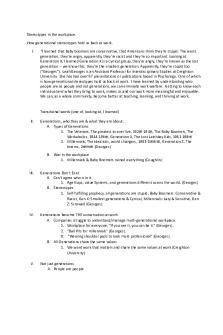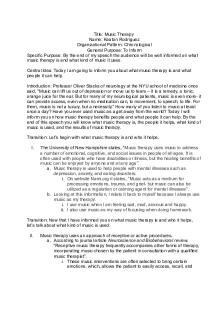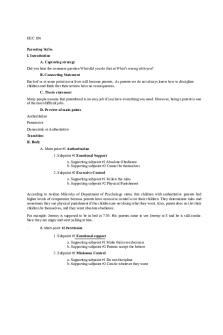Informative speech notes PDF

| Title | Informative speech notes |
|---|---|
| Course | Fundamentals Of Speech: Communication Requirement. |
| Institution | Montclair State University |
| Pages | 4 |
| File Size | 64.1 KB |
| File Type | |
| Total Downloads | 96 |
| Total Views | 127 |
Summary
Prof. Grossano...
Description
Chapter 6 Analyzing the Audience o Audience analysis- Process of gathering and analyzing information about audience to adapt your message o Audience- Centered-Think about audience throughout entire speech Attitudes- General evaluations of people,idea,object, or events o Beliefs- Level of confidence about existence Way of which things are real(Validity) o Values-Most enduring judgements about what’s good and bad in life, fewer values than beliefs o Audience disposition Topic Have a positive attitude Relevant Offer solid evidence Use vivid language Use repetition Speaker Trust people who we like Credibly Show goodwill Have integrity Identification Sharing a personal story Community Mannerism similar to audience Occasion Capture audience-required to be in audience Voluntary audience- Attend on their own free will Demographics- Statistical characteristics of a single population Age Gender Religion Ethnicity o Target audience- Most likely to influence o Interview-Person to person with an information gathering purpose Close ended Fixed alternative questions Scale questions open-ended questions o Speech Context Goals of the speech Chapter 7 Selecting a topic and purpose o Increase audience understanding and knowledge o Effect some degree of change- Persuasive o Select something you are excited about Current event
o o o o
Area of expertise Brainstorming-Spontaneous generation of ideas Once topic is chosen Narrow it down General topic- focuses more closely on goal of the speech Thesis statement- General idea about the speech Helps speech preparation Relevant to the listener Specific purpose-Outcome you want to achieve
o Chapter 23 Informative speech o Provide your audience with new ideas,new ways of thinking Transitions Presentation aids Appropriate organized patterns o Types Speeches about objects Unaminate Speeches about people Noteworthy Speeches about events Noteworthy events 9/11 Speeches about process Series of step How to speeches Speeches about issues Overview of problem Speeches of complex Complex Simple/easy to follow o Different learning styles Visual learners Best understood by viewing visual explanations Aural learners Through spoken word Read/Write learners Text based Kinesthetic learners Experience info directly Demonstrations, Hands on Multimodal More than one method Chapter 8 Developing supporting materials o Supporting materials- Info that clarifies, elaborates, and verify a speaker’s assertions o Three Functions Prove statement correct Engages with the audience
o
Elaborates on meaning of your ideas Refer orally to your sources Types Examples Brief examples- single illustration of points Extended examples- Multifaceted illustration of points of ideas,item, or event being described Hypothetical example-Illustration of something that may happen in the future if certain things occur Narrative Narrative story- Can be based on personal experiences or imaginary incidents Anecdote-Brief story of interesting,humorous, or real-life incident Testimony Firsthand findings,eyewitness,accounts, and opinions Expert lay(Non-Expert) Facts Documented occurrences Times Dates Places People involved Statistics Qualified evidence Credibility- audience member's judgement of what you are saying
Chapter 9 Finding Credible Print and Online Materials o Primary research-Provide firsthand accounts or direct evidence o Secondary research- Vast body of info gathered by others o periodical - Regularly published magazine,journals, or newspaper Chapter 10 Citing sources in your speech o Oral citations- Source of speech material that is delivered from other people’s idea o Source reliability- Level of trust in a source with credentials and a good track record o Source Qualifier- Brief description of source’s qualifications to address topic Chapter 11 1. Organizing the body of the speech 1. Arrangement- Strategic process of deciding how to order speech points into content and convincing pattern 2. Outlining- Psychical process of plotting speech points on a page with hierarchical order 3. Parts of a speech
ii.
1. Intro-Establishes speech purpose and relevance to audience and previews topic 2. Body-Speaker develops main points intended to fulfill speech purpose 3. Main points- Key ideas or primary points intended to fulfill speech purpose 4. Conclusion- Speaker redirects speech purpose Outlining 1. S.P-To inform my audience”” 1. Thesis- I will talk about “” 2. Body- 2 to 3 main points
Chapter 12 Types of organizational arrangements o Topical pattern- pattern of organizing main points as subtopics o Chronological pattern- Organizing speech points in natural sequential order o Spatial pattern-Physical proximity or direct relative to each other o Causal pattern- organizing speech points in order, first of causes and then of effects or vice-versa o Problem-solution- organizing speech points so they demonstrate nature and significance of problem Chapter 13 Outlining the speech o Working outline- preparation or rough outline that refines and finalizes specific speech purpose o Speaking outline- Main and supporting points is stated in sentence form o Phrase outline: uses partial construction of sentence form of each point instead of using complete sentences that present precise wording for each point o Key-Word outline- uses smallest units of understanding associated with specific point to outline main and supporting points Better control Freedom of movement Memory loss...
Similar Free PDFs

Informative speech notes
- 4 Pages

Informative speech
- 4 Pages

Informative Speech
- 3 Pages

Informative speech
- 3 Pages

Informative Speech
- 3 Pages

Informative Speech
- 3 Pages

INFORMATIVE SPEECH
- 6 Pages

Informative Speech
- 3 Pages

Informative Speech
- 8 Pages

Informative Speech
- 5 Pages

Informative speech
- 4 Pages

Informative Speech
- 2 Pages

Informative Speech Outline
- 5 Pages

Informative Speech Rubric
- 3 Pages
Popular Institutions
- Tinajero National High School - Annex
- Politeknik Caltex Riau
- Yokohama City University
- SGT University
- University of Al-Qadisiyah
- Divine Word College of Vigan
- Techniek College Rotterdam
- Universidade de Santiago
- Universiti Teknologi MARA Cawangan Johor Kampus Pasir Gudang
- Poltekkes Kemenkes Yogyakarta
- Baguio City National High School
- Colegio san marcos
- preparatoria uno
- Centro de Bachillerato Tecnológico Industrial y de Servicios No. 107
- Dalian Maritime University
- Quang Trung Secondary School
- Colegio Tecnológico en Informática
- Corporación Regional de Educación Superior
- Grupo CEDVA
- Dar Al Uloom University
- Centro de Estudios Preuniversitarios de la Universidad Nacional de Ingeniería
- 上智大学
- Aakash International School, Nuna Majara
- San Felipe Neri Catholic School
- Kang Chiao International School - New Taipei City
- Misamis Occidental National High School
- Institución Educativa Escuela Normal Juan Ladrilleros
- Kolehiyo ng Pantukan
- Batanes State College
- Instituto Continental
- Sekolah Menengah Kejuruan Kesehatan Kaltara (Tarakan)
- Colegio de La Inmaculada Concepcion - Cebu

